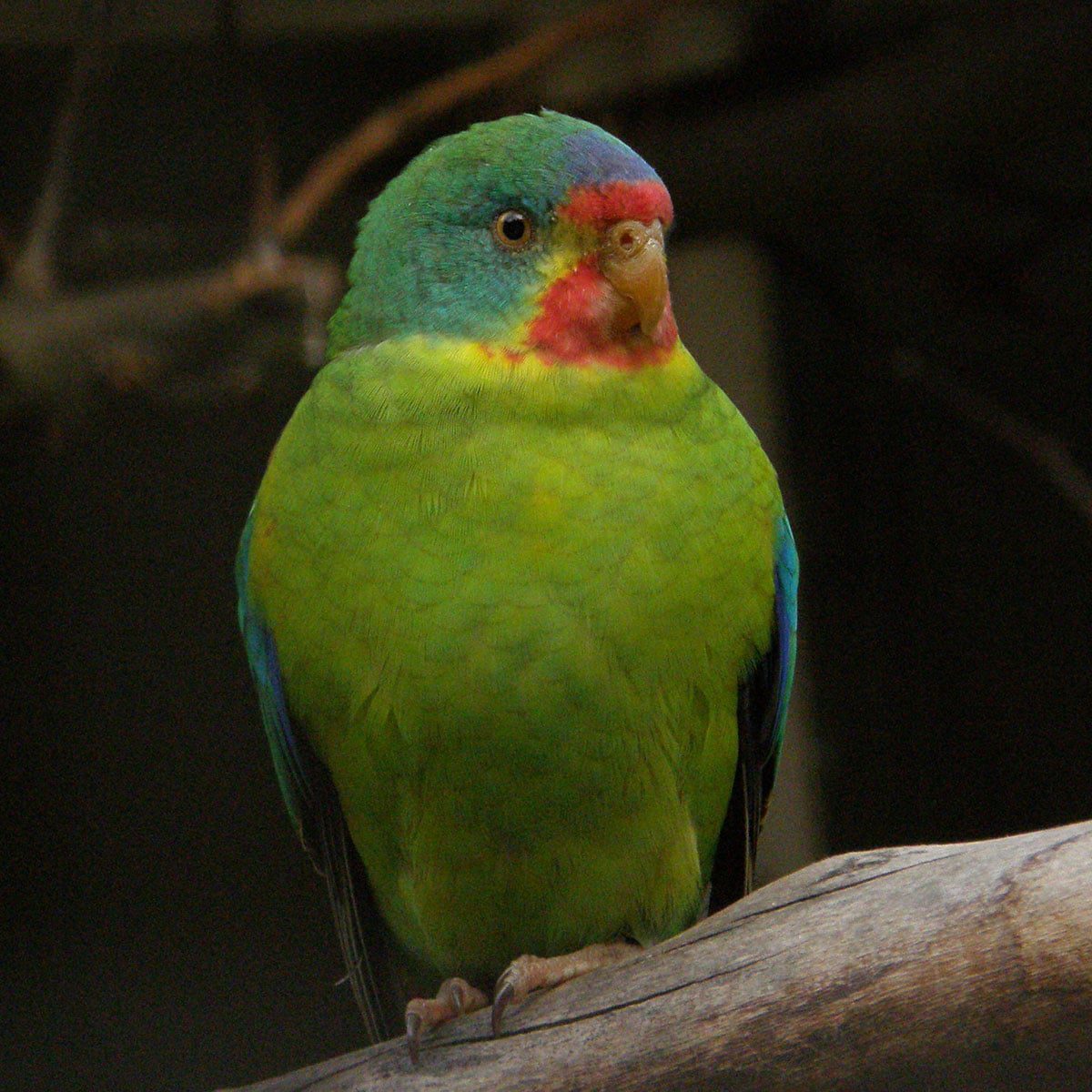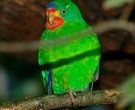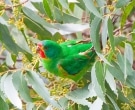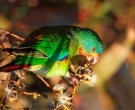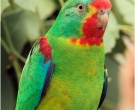Content
|
|---|
Description
The Swift Parrot (Lathamus discolor) has a length of 23 to 28 cm.. and weighs approximately 65 g..
It is a slim Parrot, medium sized wings angular and pointed tail sharpened.
The head is bright emerald green. The forecrown, the chin and center of throat, red; lores bright yellow; centre of crown blue.
The upperparts (rump), bright green. The wing-coverts and feathers under wing They are red. The feathers under the tail They are red with green scales effect. The chest and feathers belly are yellowish green.
The bill Horn is color and irises yellow.
The female is paler and extent of mask Red lower than that of males. The color of the bottom of the tail just have red.
- Sound of the Swift Parrot.
Habitat and behavior:
To the Swift Parrot It is usually seen in small groups of up 30 birds, sometimes in larger flocks (hundreds of birds) around the abundant food sources. There has also been some extraordinary reports in the enumeration of the flocks of more of 1.000 birds.
Son migratory birds. Are reproduced in Tasmania and then move to Australia continental, in autumn, for the non-reproductive season. Most of the population spends the winter in Victoria and New South Wales, before returning to Tasmania in spring. Usually they are gregarious in raising.
The playback area It is always within the 8 km from the coast, largely restricted to an area of less of 500 km² along the eastern coastal strip between Santa Helena and the Lune River, including offshore islands, as Mary Island and Bruny island.
The higher densities They occur between the After Bernier and Orford and Wellington Ridge about Hobart. A smaller breeding population is located in the North of Tasmania between Launceston and Smithton.
Reproduction:
Reproductive success is strongly related to the intensity and scope of the flowering of the Eucalyptus globulus (Tasmanian Blue Gum). In years of bad bloom, it seems that there is little breeding.
The breeding season It is mid-September to late January. Birds begin to return to Tasmania from your area of wintering on the continent at the beginning of August. Most of the population comes in mid-September. Unpaired birds upon arrival to Tasmania they cannot start breeding until November after finding mates.
The De l'Tmño Nidada is three to five eggs. The female makes the incubation. in cautiverior incubation lasts about 25 days. Young people will fly in around 6 weeks. The presence of juveniles, recently fledged at the end of January and early February suggests double broods may occur. Second hatchlings depend on food availability.
A recent study has shown that the nests of the Swift Parrot often found in close proximity to each other. Nest trees may be to only 10-15 m from, and can support up to four active nests each.
Food:
The Swift Parrot It feeds mainly on nectar, mainly of eucalyptus, but also feeds on insects psyllids and lerps, seeds and fruits.
It is a tree Harvester, forages mainly in the eucalyptus, but from time to time low to the ground to feed on seeds, fallen flowers, fruit and Lerp. During the breeding season, the nectar from the flowers of the Eucalyptus globulus (Tasmanian Blue Gum) is the main source of food.
Sometimes they voraciously consume nectar in areas very accessible and this makes them reluctant to fly making them vulnerable to attack by cats, especially when forage among low foliage. His agility and alertness in flight can also be affected by the consumption of large quantities of nectar, possibly increasing the risk of collisions with artificial or hard-to-see objects.
Distribution:
Size of the area of distribution (reproduction / resident): 21.500 km2
The Swift Parrot, as its name suggests, migrates through the bass strait, between Tasmania and the Australian continent. Comes to Tasmania in September and returned to the southeast of Australia between March and April.
You can get to be as far north as the South-East of Queensland and get up to adelaide from the West, Although the most recent sightings are restricted to the southeastern part of the State.
Conservation:
They estimated that the current population probably contains about 2.000 mature individuals and is declining.
The population of this species is suspected to be declining in line with habitat loss and degradation..
The sugar gliders they are the main predators of the broods of the Swift Parrot on the island of Tasmania, being the cause of the 85% of deaths, but they are not present on the Islands Bruny and Maria
• Current IUCN Red List category: Danger
• Population trend: Decreasing
The logging of a particular species is also responsible for the decline of population, eucalyptus, which constitute the 90% your diet.
– The Swift Parrot is classified as a species in danger of extinction in the law of conservation of biodiversity and protection of the environment of 1999 of Australia.
– The Migratory Perico It is listed as a threatened species under the Victorian Wildlife Guarantee Act. (1988). According to this law, a state action must be carried out for the recovery and future management of this species.. In addition the Migrator parakeet is classified as endangered on the list of advisory on threatened vertebrate fauna of Victoria of 2007.
"Swift Parrot" in captivity:
There are no populations in captivity, they are being handled or propagated actively by reintroducing. But, the Swift Parrot is easily propagated in captivity, and many of them are housed in private collections.
Alternative names:
– Swift Parrot (ingles).
– Perruche de Latham (French).
– Schwalbensittich, Schwalbenlori (German).
– Periquito-andorinha (Portuguese).
– Periquito Migrado (español).
scientific classification:
– Order: Psittaciformes
– Family: Psittaculidae
– Scientific name: Lathamus discolor
– Citation: (Shaw, 1790)
– Protonimo: Psittacus Discolor
Images “Swift Parrot”:
Videos "Swift Parrot"
————————————————————————————————
“Swift Parrot” (Lathamus discolor)
Sources:
– Avibase
– Parrots of the World – Forshaw Joseph M
– Parrots A Guide to the Parrots of the World – Tony Juniper & Mike Parr
– BirdLife.org
– Wikipedia
– mundoexotics.com
– environment.gov.au
– Photos:
1 – By original photograph by frank woutersderivitive work Snowmanradio (talk) 18:52, 4 October 2008 (UTC) [CC BY 2.0], via Wikimedia Commons
2 – “Lathamus discolor-captive-8-ec” by Lathamus_discolor_-captive-8. jpg: Ernst Viknederivative work: Snowmanradio (talk) – originally posted to flickr at IMG_4454.JPG and uploaded to commons at Lathamus_discolor_-captive-8. jpg. Licensed under CC BY-SA 2.0 via Wikimedia Commons.
3 – “Lathamus discolor Bruny 1” by JJ Harrison (jjharrison89@facebook.com) – Own work. Licensed under CC BY-SA 3.0 via Wikimedia Commons.
4 – bonapartemadar.hu
5 – Swift Parrot, Lathamus discolor. Photograph Geoffrey Dabb 27.04.2005 at Mount Majura nature reserve – majura.org
– Sounds: Vicki Powys (Xeno-canto)
